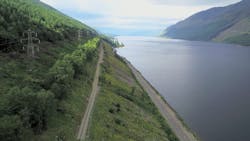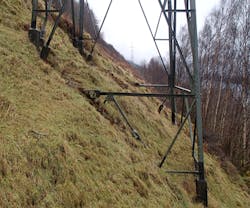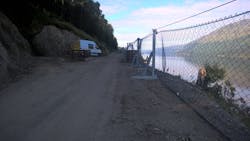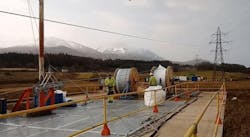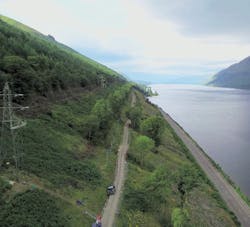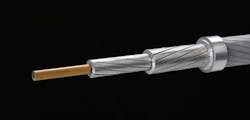SSEN Transmission Extends the Asset Life and Capacity of Existing Towers
Scottish and Southern Electricity Networks (SSEN) Transmission, operating under license as Scottish Hydro Electric Transmission Plc, owns the electricity transmission network in the north of Scotland. SSEN Transmission’s operating region covers a quarter of the UK landmass. SSEN Transmission is responsible for the planning, design, construction, and maintenance of a network which currently comprises 146 Grid Substations, 5165 km of circuits and 14,994 towers and structures.
Many of the 132 kV Network towers in the UK were constructed in the 1950’s & 60’s. These towers came with both historical ground clearance and under capacity issues. Replacement (or “rebuilding”) would likely be expensive, contentious and time consuming. This project example demonstrates how SSEN Transmission is using modern technology to extend the asset life of its existing tower fleet and future proof the network using the existing towers and modern conductors.
One recent project example is SSEN Transmission’s Fort Augustus to Fort William 132 kV OHL ACCC reconductor project. This line connects the town of Fort William with the Lochaber Smelter which needed to increase its hydro generation export capability. The existing capacity of the line was 89 MVA this needed to be increased to 198 MVA. Building a new line was not possible given the urgency. Using the high-capacity, low-sag ACCC® Conductor allowed SSEN to reuse 97% of the existing structures.
SSEN Transmission’s Safety Culture insures that “if it’s not safe we won’t do it.” , so despite the many challenges that this project had, safety remained our top priority, the project finished with more than 700 consecutive days on site without a lost time injury. The project team needed to determine the best way to upgrade the line while minimizing the impact to the local communities surrounding it. The location of the line, which runs along highways, crosses public roads, railway lines and the Caledonian Canal, following steep terrain throughout its route, added to the challenges that the team needed to be creative to overcome.
The 44 km double circuit Fort Augustus to Fort William 132 kV line was originally built in 1955 using Lynx size ACSR conductor with Horse size ACSR earth wire. A design challenge was to meet 6.7 metres of minimum clearance in all areas during maximum operation. Because of the economic importance of the expanding smelter business which was to begin producing engineered aluminum products and not just commodity aluminum, pressure to complete the project quickly was also recognized.
Over the years a number of investments had already been made to improve technology in both the power station and the smelter as well as extending the hydro scheme at the Spey dam. Alvance’s hydro facility generates 64 MW on average so SSEN Transmission is a net importer of power over the course of a year. The improved efficiency (reduced line losses) of the upgraded ACCC conductor was considered a plus, not to mention the smelters expansion that was planned to create many new jobs.
Because the terrain is so steep and the important A82 highway had to remain open, much care was taken to prevent landslides. Extensive rock netting was also installed as a slope protection measure along the side of Loch Lochy – One of the longest continuous netting projects in Europe.
SSEN Transmission and construction firm Balfour Beatty devised a stringing plan based on very difficult equipment access points with support from CTC Global, the developer of the ACCC Conductor and Lamifil, the conductor manufacturer. To prevent loosening of the conductive strands between the Bullwheel tensioner and the first sheave wheel mounted on each structure, the tensioners were located approximately three times the height of the structure away from the structures where pulling took place and the payout reels were located approximately 15 meters away from the tensioners.
As part of the Key Risks and Mitigation Plan, an Emergency Return to Service (ERTS) plan was also established with all participants to ensure that any outage be limited as much as possible. Many scenarios were considered and ERTS plans were devised for each of the most challenging sections. ERTS timeframes had to be less than 10 hours due to the damage that could potentially be suffered by the smelter and of course the 11,700 other customers supplied from this radial circuit, which cannot be resupplied from other areas on the lower voltage distribution network.. The need to keep these customers supplied at all times, meant the reconductoring and earthwire replacement had to be carried out while the circuit on the other side of each tower remained live at 132 kV. This meant the establishment of Equipotential Zones (EPZ’s) at each of the puller and tensioner locations to protect the team from induced voltages. In the picture (figure 3) you can see the metal meshed platform that all the equipment is on so that no potential difference can arise over the working area.
The use of an abandoned railway path provided decent access and helped greatly during the course of construction.
As SSEN Transmission considered all project challenges and various conductor options including AAAC Upas and other HTLS conductors, the ACCC ULS Monte Carlo size conductor checked all the boxes. It offered the lowest amount of sag – even under anticipated ice and wind load conditions, was no heavier than the ACSR conductor it replaced, had been previously and successfully used by SSEN Transmission, and offered many other second tier benefits such as resistance to cyclic load fatigue and corrosion, all while more than doubling the capacity of the ACSR conductor it replaced. Reconductoring vs rebuilding also saved years of time in permitting and construction, significant environmental advantages, and tens of millions of dollars in project costs.
Rob McDonald, SSEN Transmission Managing Director of Transmission stated: “By utilising new technology, the team were able to minimise the impact on the local community and keep the power flowing. The increase in capacity will go a long way to accommodate growth in renewable electricity in the area and support the transition to net zero.”
After nearly 70 years in service, the capacity of the Fort Augustus — Fort William line was doubled. The success of the project which was independently recognized with the Utility Week award of “Capital Project of the Year” was due to tremendous support by stakeholders and exceptional collaboration with SSEN Transmission’s strategic partners Balfour Beatty, WSP, Energy Line, Lamifil and CTC Global.
By using this technology and strengthening the existing towers only 5 of the 156 towers needed to be replaced, retaining 97% of the towers - sustainability at its best!
About the Author
Pat Howe
Pat Howe is the Head of Transmission Customer Connections at SSEN Transmission in Scotland. His team are responsible for connecting renewable generation projects from 132kV to 400kV in the North of Scotland. Pat is a Chartered Electrical Engineer, 400kV SAP and has over 40 years’ experience in Distribution and Transmission systems and Renewable Generation. He has pioneered the use of ACCC in the SSEN Transmission network.
Dave Bryant
Dave Bryant is Director of Technology at CTC Global Corporation in Irvine, California. Dave was a co-inventor of the patented ACCC® conductor and ancillary hardware components. His 40+ year background as a design engineer focused on the use of advanced composite materials in numerous industrial applications which helped expedite the development, testing, and commercialization of the ACCC conductor which has been deployed to more than 1,000 projects in 60 countries.
